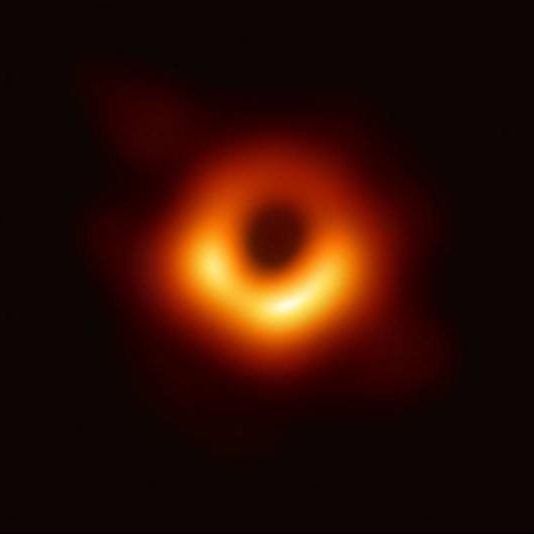
Hi everyone,
[vcex_spacing size=”30px”]
Lots of excitement today as scientists revealed the first image ever taken of a black hole. The picture above shows the glow of hellishly hot gas surrounding the black hole, with the light blotted out within the black hole’s event horizon – the boundary where nothing, not even light, can escape the ferocious gravitational pull. The brighter glow at the bottom is caused by the gas rotating around the black hole, which boosts the light of the stuff moving towards us, as Albert Einstein predicted a century ago.
[vcex_spacing size=”30px”]
The image was taken with the Event Horizon Telescope, a global network of radio telescopes whose light is combined to act like a single telescope almost as big as the Earth. Large telescopes allow smaller details to be seen, and it requires an Earth-sized telescope to glimpse the tiny region around a distant black hole.
[vcex_spacing size=”30px”]

The Event Horizon Telescope is a global network of eight radio telescopes
[vcex_spacing size=”30px”]

The Atacama Large Millimeter Array in Chile is one of several around the globe that work in unison to create the Event Horizon Telescope. Image credit: Y. Beletsky and ESO
This isn’t your run-of-the-mill black hole. It’s one of the largest known – called a supermassive black hole – that resides about 50 million light years away in a giant galaxy named M87. A Hubble Space Telescope image of M87 is shown below, and if you look closely you can see a jet emanating from its center – that’s materially being ejected at high speeds from near the supermassive black hole. The image of the black hole’s event horizon released today is on a much, MUCH smaller scale as we peer into the very heart of this galaxy.

Hubble Space Telescope image of the galaxy M87, home to the black hole that was imaged.
Astronomers believe that every galaxy hosts a supermassive black hole at its center. But M87’s black hole is an especially big beast, weighing the equivalent of more than six billion Suns. In fact, astronomers aren’t even sure how such enormous black holes formed.
[vcex_spacing size=”30px”]
The Event Horizon Telescope has also been busy trying to snap a picture of the supermassive black hole lurking at the center of our own galaxy, the Milky Way, and we can expect to see it in the not-too-distant future. Our galaxy’s black hole has the mass of about four million Sun’s – a tiny fraction of the mass of M87’s black hole – but still nothing you’d want to get too close to.
[vcex_spacing size=”30px”]

Getting too near a black hole can ruin your day. Artwork by Vadim Sadovsk/Shutterstock.
[vcex_spacing size=”30px”]
If you’d like to know more, just click
here.
[vcex_spacing size=”30px”]
The science journal Nature has a nice video summary of today’s news and a good introduction to black holes:
[vcex_spacing size=”30px”]
And, if you’d like, you can also read the full scientific papers announcing the discovery
here, published in the
Astrophysical Journal.[vcex_spacing size=”30px”]
If you’ve got questions, don’t hesitate to send me an email.
[vcex_spacing size=”30px”]
Best regards,
***
Sign up for AstroAlerts from Lowell Observatory’s Deputy Director for Science, Dr. Michael West, to receive breaking news stories from the world of astronomy, as well as information about upcoming meteor showers, eclipses, International Space Station sightings and other astronomical events.
Want a taste of what you will be receiving? Click HERE for an archive of the most recent AstroAlerts sent to subscribers.




